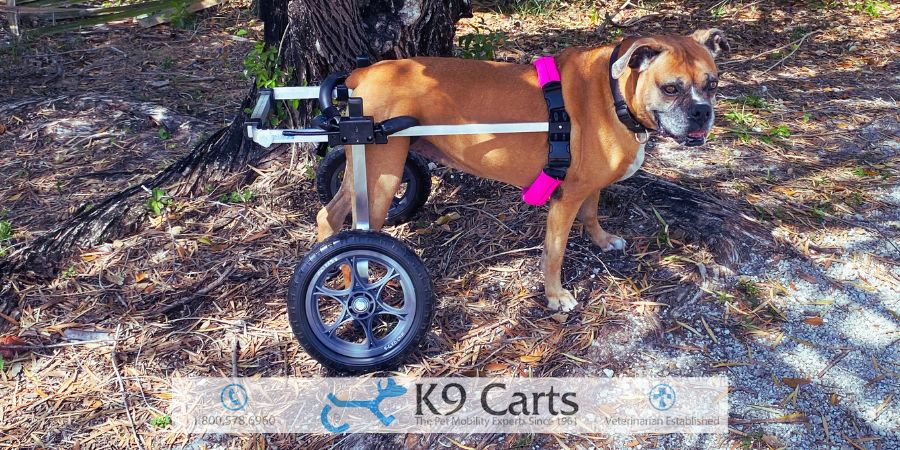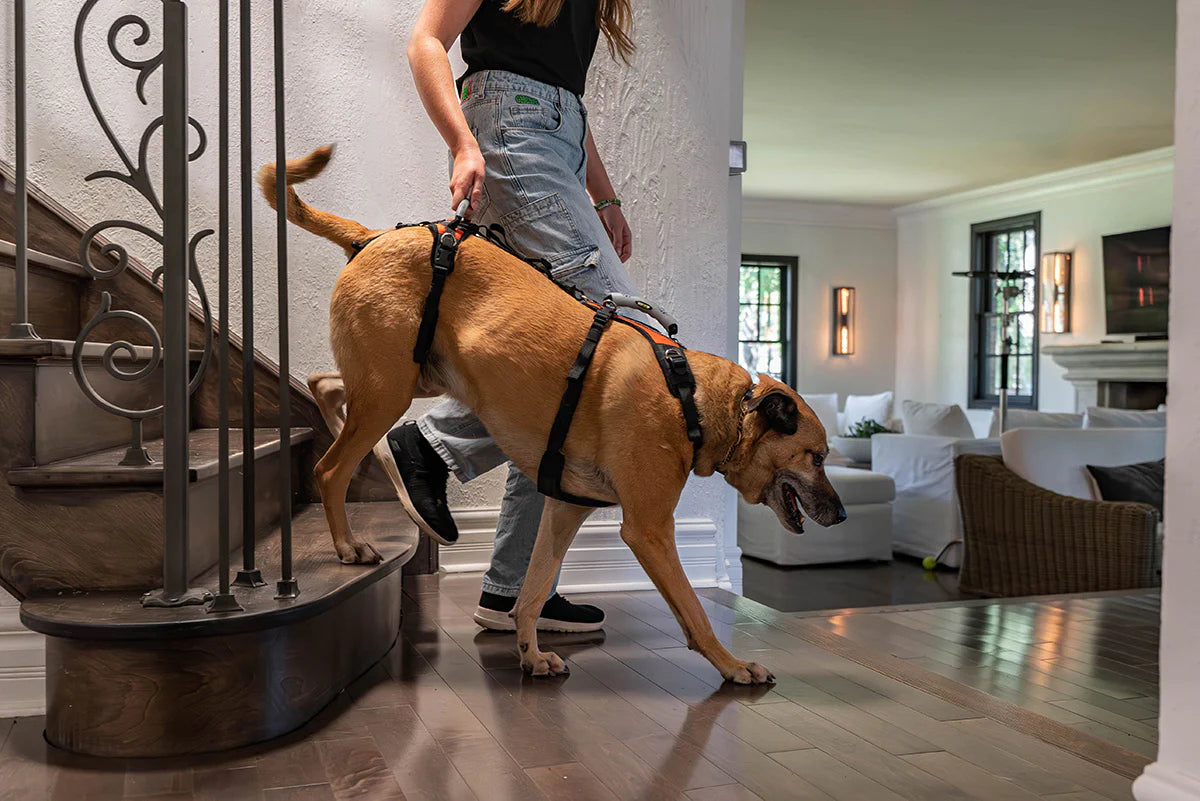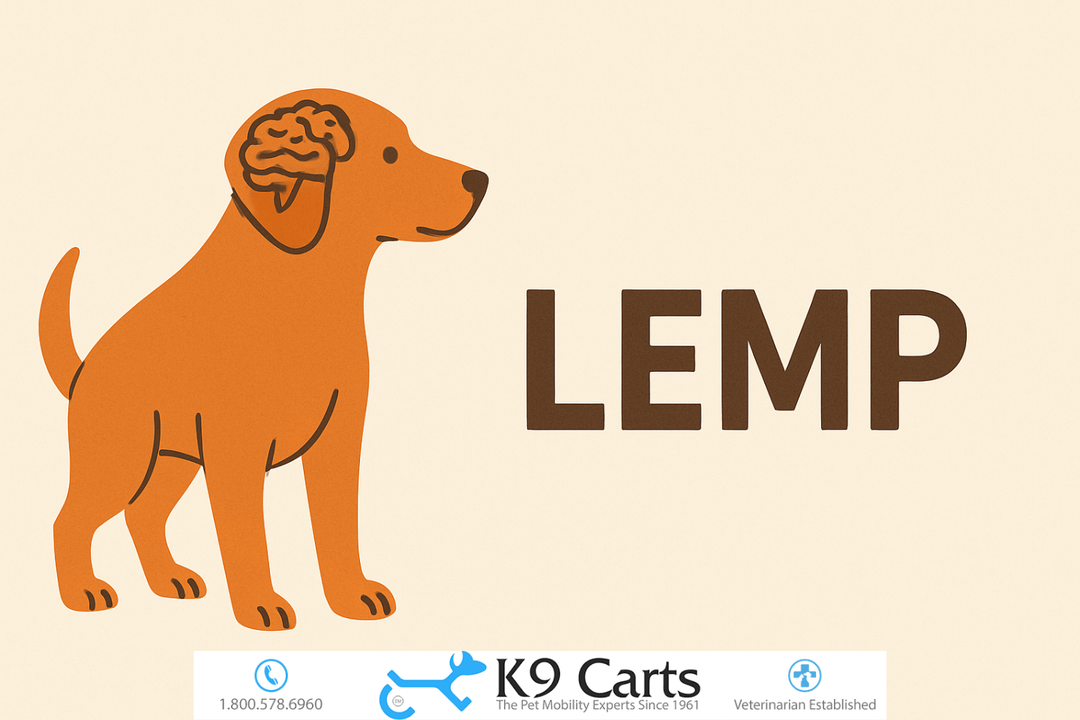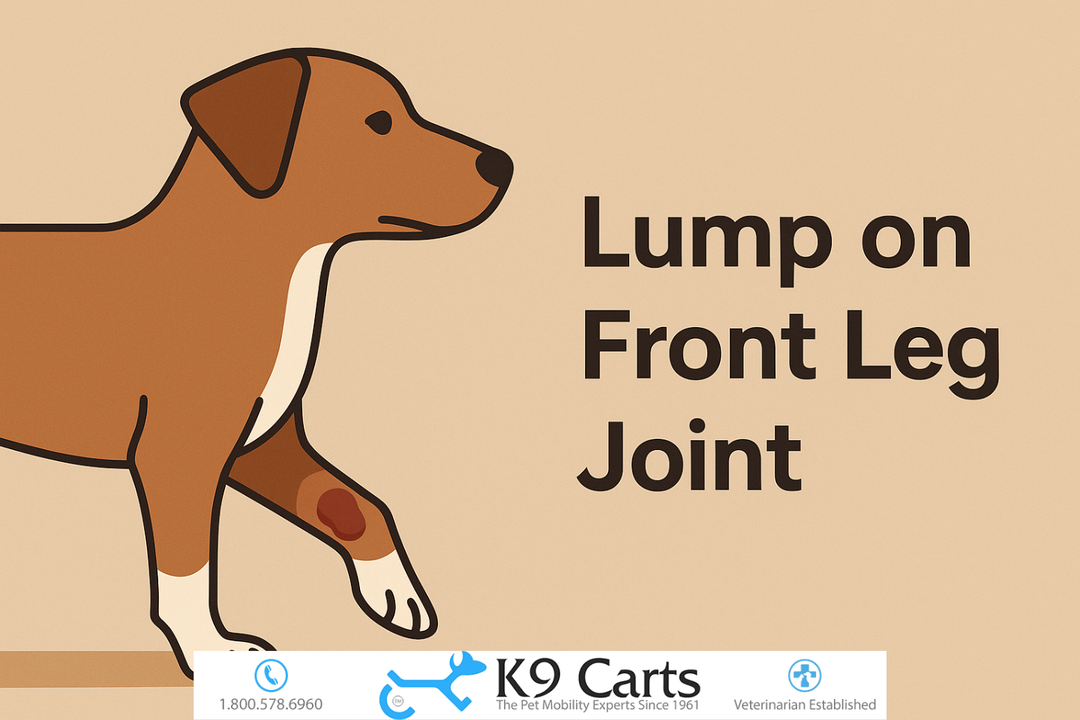Dog Limping on Back Leg: 5 Possible Causes and Solutions

As dedicated caretakers of our canine companions, we often find ourselves confronted with various health challenges, including the distressing sight of our dogs limping on a back leg. This common issue raises immediate concerns about the well-being of our furry friends.
At K9 Carts, we understand the depth of the bond between you and your dog. That's why we're committed to not just providing custom-built dog wheelchairs and innovative dog lift harnesses like the Help 'Em Up Harness, but also to offering insights into the possible causes and solutions for your dog's discomfort.
On this page, we'll go through the complexities of canine anatomy and gait, discuss common causes of limping, and examine both traditional and innovative treatment options, including our specialized assistive devices.
Understanding Canine Anatomy and Gait
A brief overview of dog leg anatomy
Dogs, like humans, rely on a complex musculoskeletal system that enables movement and activity. The anatomy of a dog's leg is a marvel of nature, designed for endurance and agility. Each hind leg comprises several key components: the femur or thigh bone, the tibia and fibula in the lower leg, and the tarsus, equivalent to the human ankle. These bones are connected by joints, namely the hip, knee, and hock, allowing for a range of movement.Normal canine gait and movement
A healthy dog's gait is a symphony of coordinated movements. When observing a dog walk, you'll notice a rhythmical pattern where each limb moves in harmony. The hind legs provide the majority of a dog's propulsion, pushing off the ground with strength and precision. This motion is critical not only for mobility but also for maintaining balance and posture.Importance of recognizing abnormalities
Recognizing abnormalities in your dog's gait is crucial for early intervention and effective treatment. A limp, favoring one leg, or an altered walking pattern can be early signs of underlying health issues. Being observant and responsive to these changes is key to maintaining your dog’s health and quality of life. Early detection often leads to more successful treatment outcomes, allowing our beloved pets to lead active and comfortable lives.Common Causes of a Dog Limping on Back Leg
When our dogs start limping on a back leg, it's a signal that something isn't right. This section will guide us through various causes, ranging from injuries to chronic conditions. Understanding these causes is the first step in seeking the right treatment and care. Each dog's situation is unique, and what might be a minor issue for one could be more serious for another.
In the following sections, we'll explore the specifics of these conditions, providing a clearer picture of what our canine friends might be experiencing. This knowledge is not just about treatment but also about prevention and early intervention, ensuring our dogs stay happy and healthy for as long as possible.
1. Traumatic Injuries
Sprains and strains
Sprains and strains are among the most common injuries causing limping in dogs. A sprain involves the stretching or tearing of ligaments that connect bones, while a strain affects muscles or tendons. These injuries often occur during vigorous play, sudden movements, or accidents. Symptoms include limping, swelling, and discomfort. Rest, anti-inflammatory medications, and in some cases, physical therapy, are key to recovery.Fractures
Fractures, or broken bones, are serious injuries that can cause intense pain and severe limping. They typically result from significant trauma, like a fall or collision. Symptoms include visible deformity, swelling, and an inability to bear weight on the limb. Immediate veterinary care is crucial for proper diagnosis and treatment, which may involve splinting, casting, or surgery.Dislocations
Dislocations occur when the ends of bones are forced out of their normal positions, often in joints like the hip or knee. These injuries can be extremely painful, leading to severe limping or an inability to use the leg. Immediate veterinary attention is necessary to realign the bones, followed by rest, medication, and possibly surgery or physical therapy for full recovery.2. Degenerative Conditions
Hip Dysplasia
Hip dysplasia is a common degenerative condition in dogs, particularly in larger breeds. It's characterized by a malformation of the hip joint, leading to a loose fit between the femur and the pelvic socket. This condition can cause pain, stiffness, and limping in the back legs. Early detection is crucial for managing this condition. Treatment often includes weight management, physical therapy, and in some cases, pain medication or surgery.Osteoarthritis
Osteoarthritis, also known as degenerative joint disease, is a progressive condition where the cartilage in the joints breaks down, leading to pain and stiffness. It often affects older dogs but can be seen in younger dogs too, especially those with joint injuries or congenital joint abnormalities. Treatment focuses on alleviating pain and maintaining mobility through weight management, exercise, medications, and sometimes joint supplements.Intervertebral Disc Disease (IVDD)
IVDD is a condition where the cushioning discs between the vertebrae of the spinal column either bulge or burst (herniate) into the spinal cord space. This can cause pain, nerve damage, and in severe cases, paralysis. Symptoms can range from mild discomfort to severe pain and inability to walk. Treatment varies from conservative management like rest and anti-inflammatory medications to surgical interventions in more severe cases. Early diagnosis and treatment are critical for the best outcomes.3. Infections and Inflammatory Conditions
Lyme Disease
Lyme disease, caused by the bacterium Borrelia burgdorferi, is transmitted to dogs through tick bites. This condition can lead to a range of symptoms, including fever, swollen joints, and limping. It's important to catch this disease early, as chronic Lyme disease can lead to more severe joint inflammation and long-term discomfort. Treatment usually involves antibiotics and supportive care to relieve symptoms.Panosteitis
Panosteitis is an inflammatory condition primarily affecting young, large breed dogs. It causes sudden, intermittent lameness and pain in one or more legs. The exact cause of panosteitis is unknown, but it's believed to be related to rapid growth. Fortunately, this condition is usually self-limiting and resolves as the dog matures. Treatment focuses on managing pain and maintaining a healthy diet to support growth.Osteomyelitis
Osteomyelitis is an infection in the bone, often caused by bacteria or fungi, which can lead to limping and pain in dogs. It may occur due to an open wound that allows pathogens to enter the bone or can be a complication of a systemic infection. Signs include lameness, fever, and swelling. Treatment typically involves antibiotics or antifungal medications and may require surgical intervention to remove infected bone tissue. Early and aggressive treatment is essential for a successful outcome.4. Cancer
Bone cancer (osteosarcoma)
Osteosarcoma is the most common type of bone cancer in dogs, often affecting the limbs and causing limping or lameness. This aggressive cancer can cause significant pain and swelling in the affected area. Early detection is crucial, as the cancer can spread rapidly. Treatment typically involves a combination of surgery, chemotherapy, and pain management. Prognosis depends on various factors, including the cancer's stage and the dog's overall health.Soft tissue tumors
Soft tissue tumors in dogs can vary greatly in terms of malignancy and impact on health. Some may cause limping if they grow near or on the limbs, interfering with movement or causing pain. Diagnosis often requires a biopsy to determine the nature of the tumor. Treatment options vary depending on the type and location of the tumor and can include surgery, radiation therapy, and chemotherapy. Regular check-ups and early intervention play a key role in managing these conditions.5. Nerve Damage
Sciatic nerve issues
The sciatic nerve is one of the largest nerves in a dog's body, running from the lower back down to the hind legs. When this nerve is injured or compressed, it can lead to weakness, pain, and limping in the back leg. Causes of sciatic nerve issues include spinal disorders, traumatic injuries, and tumors. Symptoms may include difficulty standing up, loss of reflexes, and muscle wastage. Treatment varies based on the underlying cause and may include anti-inflammatory medications, physical therapy, and in severe cases, surgery.Peripheral neuropathy
Peripheral neuropathy refers to the damage or disease affecting peripheral nerves. This condition can lead to hind leg weakness, pain, and coordination problems in the limbs. In dogs, it might result from various causes, including infections, toxins, metabolic disorders, and hereditary conditions. Symptoms typically include an unsteady gait, muscle weakness, and reduced reflexes. Managing this condition involves treating the underlying cause, supportive care, and in some cases, rehabilitation therapies to improve muscle strength and coordination.Identifying the Precise Cause: Symptoms and Diagnosis
Observation and physical examination
The first step in identifying the cause of your dog's limping is careful observation and a thorough physical examination. Pay attention to signs like visible discomfort, changes in walking style, reluctance to stand or move, or an increase in limping after laying down then waking up. A veterinarian will examine your dog, focusing on their legs and spine, checking for pain responses, swelling, and abnormalities in movement.Diagnostic tools and tests
X-rays
X-rays are a fundamental tool in diagnosing bone and joint problems in dogs. They can reveal fractures, signs of arthritis, and changes in joint structure, helping to pinpoint the cause of limping.MRI or CT scans
For more detailed imaging, especially of soft tissues, nerves, and the spinal cord, MRI (Magnetic Resonance Imaging) or CT (Computed Tomography) scans can be invaluable. These scans are particularly useful in diagnosing conditions like IVDD or nerve damage.Blood tests
Blood tests can help identify underlying conditions like infections (e.g., Lyme Disease) or inflammatory diseases that might be causing limping. They provide valuable information about the dog's overall health, which is crucial for a comprehensive diagnosis.Biopsies
If a tumor or growth is suspected, a biopsy may be necessary. This involves taking a small tissue sample for analysis, helping to determine the nature of the growth and the best course of treatment.Consultation with a veterinarian and specialists
Consulting with a veterinarian is vital in diagnosing and treating your dog's limping. In some cases, they might refer you to a specialist, such as an orthopedic surgeon or a neurologist, for more advanced care. These professionals can offer more specialized diagnostic tests and treatments, ensuring your dog gets the best possible care for their specific condition.Treatment Options
When it comes to treating a dog that is limping on a back leg, there is a range of options available, depending on the underlying cause. It's important to tailor the treatment to the specific needs of your dog, ensuring the best possible outcome.
Here, we'll briefly introduce the various treatment avenues, which will be expanded upon in the following sections. From conservative management practices like rest and pain management to more advanced options like surgery and medications, the aim is to relieve pain, promote healing, and improve quality of life.
Additionally, lifestyle modifications and assistive devices can play a significant role in supporting a dog's recovery and ongoing mobility. In the next sections, we will explore each of these treatment options in detail, providing insights into how they can help our canine companions lead a more comfortable and active life.
1. Conservative Management
Rest and limited activity
Rest is often the first step in treating a dog with a limping back leg. Limiting activity helps prevent further injury and allows the healing process to begin. This might mean shorter, more controlled walks, restricting playtime, and avoiding stairs or jumping. It's important to follow your veterinarian's guidance on the level of activity appropriate for your dog's condition.Pain management
Pain relief is crucial in managing limping in dogs. Your veterinarian might prescribe pain relief medications or recommend over-the-counter options. It's important to never give human medications to dogs without consulting a vet, as some can be harmful to them.Physical therapy and rehabilitation
Physical therapy can be a key component in recovering from an injury or managing a chronic condition. This might include exercises to improve strength and flexibility, massage to reduce discomfort, and hydrotherapy for low-impact movement.Chiropractic care
For some dogs, chiropractic care can provide relief and improve mobility. This should always be performed by a professional trained in animal chiropractic techniques. It can be especially beneficial for conditions involving the spine or joint misalignments.2. Surgical Intervention
Orthopedic surgeries
In some cases, surgery is the best option to address the underlying cause of a dog's limping. Orthopedic surgeries can repair broken bones, correct joint abnormalities, and alleviate pain.
Common procedures include repairing fractures with plates and screws, ACL (anterior cruciate ligament) repairs in the knee, and hip replacements for severe hip dysplasia. The decision for surgery depends on factors like the dog's age, overall health, and the severity of their condition. Post-surgical care is essential for a successful recovery and includes rest, pain management, and often physical therapy.








